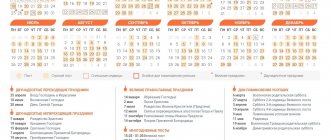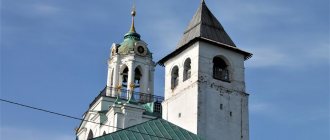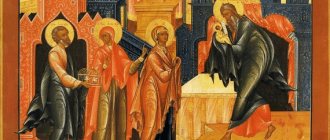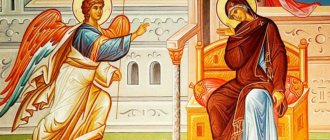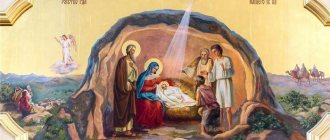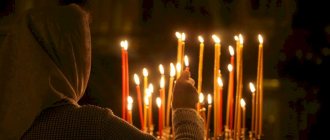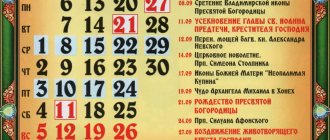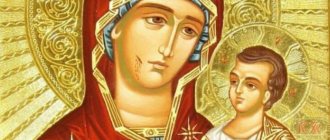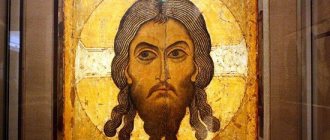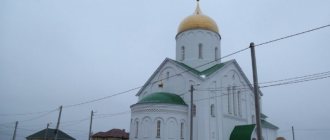What do the twelve holidays mean?
Orthodox holidays dedicated to the events of the life of Christ and the Virgin Mary are called Twelve. There are twelve of them in total. All of them are considered great and are second in importance only to Easter.
Based on their theme, these holidays are divided into:
- Lord's;
- Mother of God.
There are also divisions according to the time of celebration:
- transient or mobile;
- intransient or immovable.
For believers who constantly go to church, the Twelve Feasts are very important. Their significance was predetermined by our ancestors, from the time of the life of Christ and the Virgin Mary. In our time, religious, cultural and folk values are intertwined. And in 1920, church holidays were state holidays. The solemnity of these holidays has not been lost to this day.
Circumcision of the Lord
When: January 14 (January 1, old style) What we celebrate: the rite of circumcision and the naming of Jesus
Circumcision of the Lord. Albanian icon. 1760-1780. National Museum of Medieval Art, Korca
Circumcision of the Lord. XVIII–XIX centuries Kunsthandel Maik Gunther, Cologne
Candlemas. XV century timing belt
According to the Old Testament law, on the 8th day after Christmas, the Baby's foreskin was circumcised and given a name. This ritual confirmed that Jesus belonged to the people of Abraham, that is, his right to be the Messiah. It is also considered a prototype of Baptism - a sign of the covenant made with the Lord.
Icons and frescoes with the scene of the Circumcision of the Lord are extremely rare, and there are no mysterious details on them. We see Mary and Joseph bringing Jesus, as well as a priest with instruments bending over a child to perform an operation. Sometimes the figure of St. Basil the Great (IV century) is also painted on this icon, because his memory is celebrated on the same day.
Do not confuse this subject with the popular Candlemas icon, which depicts another bringing of the Child to the Temple, on the 40th day after Christmas - this time for thanksgiving sacrifices and the dedication of the firstborn to God. The priest here also leans towards Jesus, but he already has a name - this is the old Simeon the God-Receiver, who was predicted that he would not die until he saw the Messiah.
The twelfth holidays of the Orthodox Church, the essence
The Twelve Festivals, as mentioned above, are twelve major religious events that are celebrated by Christians. Their essence is to remind us of the Virgin Mary of her repentance and sacrifice, of Jesus Christ. All of them are associated with the decisive moments of their life, from birth, to finding eternal peace and tranquility. These days remind us of good deeds in the name of people and goodness.
Cathedral of the Blessed Virgin Mary
When: January 8 (December 26, old style) What we celebrate: gratitude to the Virgin Mary, who gave birth to a son the day before
Cathedral of Our Lady. Late XIV - early XV centuries. Tretyakov Gallery
Cathedral of Our Lady (fragment). Late XIV - early XV centuries. Tretyakov Gallery
Cathedral of Our Lady (fragment). Late XIV - early XV centuries. Tretyakov Gallery
Twelfth holidays description, briefly
Let us consider all the twelve holidays according to their division into movable and non-movable.
So, the non-transitionable ones include:
The Nativity of the Blessed Virgin Mary occurs on September 21. This is the birthday of the Virgin Mary, who was born to elderly but happy parents in Nazareth. She later became the mother of Jesus Christ.
The Exaltation of the Cross of the Lord is celebrated on September 27. This holiday is dedicated to the cross as a symbol of heavenly, eternal life. In addition, the sacrifice of Jesus is associated with the cross; with his act he atoned for the sins of all people on earth.
Introduction to the Temple of the Virgin Mary
December 4. It was on this day that Mary first entered the temple as a three-year-old child.
Christmas Day January 7th. The birth of the baby Jesus Christ by the immaculate Virgin Mary.
Epiphany or as I also call it Epiphany on January 19th. It is on this day that the appearance of the faces of the Holy Trinity occurs. And the baby Jesus was baptized in the Jordan River under the blessing of God the Father.
Meeting on February 15th. The parents of the Divine Infant brought him to the temple on the fortieth day from his birth, as stated the law of Moses, established in memory of the exodus of the Jews from Egyptian lands and liberation from slavery. Because Jesus was the firstborn of his parents, and they were not rich; he was brought to the temple for a rite of dedication to God. It was at this moment that Elder Simeon was in the temple, and his meeting with the baby Jesus Christ took place. Simeon was one of many scribes who translated the Bible from Hebrew back in the 3rd century BC. While working, he saw the lines “The virgin will be with child and give birth to a son.” He wanted to change "Virgo" (virgin) to "Woman". At that moment, an angel appeared to him and told him that Simeon would live until he himself saw the fulfillment of this prophecy.
Annunciation April 7. It was on this day that the Holy Spirit told Mary about the immaculate conception and her birth of the Child of God.
Transfiguration
celebrated on August 19th. It was on this day that Christ appeared to his disciples in white shining robes, announcing that all suffering has an end and eternal life awaits everyone who believes in it.
Theotokos Dormition of the Blessed Virgin Mary
August 28. A sad and mournful day, accompanied by funeral prayers for consolation and edification to all Christians.
Moving holidays include:
Palm Sunday or the Entry of the Lord into Jerusalem.
It is celebrated a week before Easter. It was on this day that Jesus was welcomed as the savior and image of God on earth. His path was covered with clothes, expecting blessings and salvation from suffering.
The Ascension of the Lord is celebrated 40 days after Easter. The holiday is dedicated to the end of Christ's earthly life and his ascension to heaven to God.
The Holy Trinity is celebrated on Sunday after 50 days from Easter. It is believed that God has three faces:
- God is the father;
- God is a son;
- Holy Spirit.
Even in prayers all three hypostases of God are mentioned. The essence of this holiday is to express gratitude to God for the revival and maintenance of life, for giving strength to all people. On the day of the Holy Trinity, people go to church and pray to cleanse their souls of all bad things and find peace and love. In addition, they made amulets and placed them at home. Before Trinity comes Parents' Saturday, when it is customary to remember departed relatives and loved ones.
Since the date of Easter changes every year, therefore the last three holidays are called moving (the dates are different every year).
Nativity
When: January 7 (December 25, old style) What we celebrate: the birth of Jesus Christ
Ivan Markov. Nativity. 1701. Timing
Ivan Markov. Nativity of Christ (fragment). 1701. Timing
Ivan Markov. Nativity of Christ (fragment). 1701. Timing
Christmas icons come in two versions - laconic and detailed, with details. Let's take a look at the icon from the Russian Museum of 1701: there are few details here. Icon painter Ivan Markov strictly follows the text of the New Testament: angels sing in heaven, the Holy Family in a cave, a baby lies in a wooden manger with legs like a bed. On the sides of Mary and Joseph are the shepherds who came to worship the newborn. Below is the chronologically previous episode: an angel appears to the shepherds and tells about a miracle. The charm of the icon is given by the tiny white goats and sheep that frolic on the green grass under the feet of the characters.
Let's study the Nativity icon from the collection of the Russian Museum in tenfold magnification
Nativity. XVIII century NGOMZ
Nativity of Christ (fragment). XVIII century NGOMZ
Nativity. XV century Sergiev Posad Museum-Reserve
Much more often there are icons that are full of details from the apocrypha - religious texts that are not included in the biblical canon. Such, for example, is an icon from the Novgorod Museum (XVIII century). The Magi on horseback follow the guiding star of Bethlehem, and then in the cave they bow before the Baby and bring him gifts. Here are the new details: the old man, personifying the “spirit of doubt,” tempts Joseph with the question of whether the virgin birth is possible (here on the left); Above them is another Joseph - he is sleeping, and an angel warns him of the coming massacre of the infants. The actual murder of newborn children in this icon is depicted in the lower part: pay attention to King Herod, who sits on the throne and gives the order. We also see how the Virgin Mary and Jesus escaped from the beating (they are leaving on a white donkey, this scene is called “Flight into Egypt”), as well as little John the Baptist in the arms of the mother of the Righteous Elizabeth (the rock opened up in front of them, inside which they hid ).
Let's study the Nativity icon from the collection of the Novgorod Museum-Reserve in fivefold magnification
A typical detail of the icon is the central figure of the Mother of God on a red bed, although, as you can see, this condition is not always met. Even in the icons of the Nativity, two women are usually depicted who are preparing to dip the newborn Jesus in a round font - these are the midwives Geloma and Salome. The latter did not believe that Maria remained a girl after giving birth, and decided to check. Because of this, her hand withered, but then she repented, touched the swaddling clothes of the newborn Christ and was healed.
Twelfth holidays calendar 2019
Dates of the twelve holidays for the current year. First, let's recall the dates of non-transitionable holidays, and after them we will indicate the transferable ones.
So, holidays whose dates do not change:
- Christmas
Day January 7; - Epiphany
(Epiphany) January 19; - Meeting
February 15; - Annunciation April 7
- Transfiguration of the Lord
August 19; - Assumption of the Blessed Virgin Mary
August 28; - Nativity of the Blessed Virgin Mary
on September 21; - Exaltation of the Holy Cross
on September 27; - Entry into the Temple of the Virgin Mary
on December 4.
Moving holidays this year will be:
- Entry of the Lord into Jerusalem
April 21; - Ascension
of the Lord June 6; - Trinity June 15;
Now you know the exact dates of the holidays.
Twelfth holidays calendar 2021, 2021
Next year 2021, the moving holidays will fall on the following dates:
- Entry of the Lord into Jerusalem April 12;
- Ascension of the Lord May 28;
- Trinity June 7th.
Fixed holidays do not change their dates, so we will not repeat them. They can be viewed in the previous paragraph.
Icons of the Twelfth Holidays
Each Orthodox holiday has its own icon. Now let's present these icons with a brief description of each.
Icon of the Nativity of Christ . It depicts the born baby Jesus with his mother the Virgin Mary. Three kings (Balthasar, Melchior, Caspar) present gifts to the baby, and the angel holds the guiding star of Bethlehem in his hands. The icon is very beautiful and peaceful.
Entry of the Lord into Jerusalem, Palm Sunday
Icon of the Annunciation . It is dedicated to the meeting of the Virgin Mary with Archangel Gabriel, who brought her good news about the birth of her son, the Most High. And they will call him Jesus.
Ascension of the Lord
Icon of the Nativity of the Virgin Mary. The icon tells about the miraculous birth of Mary to her parents Joachim and Anna. Anna was barren and this upset her husband. But God's provision helped them find a daughter.
Icon of the Dormition of the Virgin Mary. It depicts the moment of the departure of the Mother of God from earthly life to eternal life.
Icon of the Holy Trinity. One of the most famous icons, on which you can see God the Father, God the Son and the Holy Spirit in the Upper Room of Zion. According to legend, Abraham saw three travelers on the road. In one of them he recognized God and honored them. He sat them down in the shade of an oak tree, fed and watered them.
Icon of the Transfiguration of the Lord.
The icon depicts Jesus in rays of light and his disciples, whom the Almighty called to pray on Mount Tabor. It is in the environment of Peter, John and James that the appearance of the face takes place
Icon of the introduction of the Mother of God into the temple . The icon depicts three-year-old Mary coming to the temple for the first time with her parents. This event is an important stage in her life, which will smoothly lead her to the birth of the Infant of God.
Icon of the Descent of the Holy Spirit . It depicts the moment when the Mother of God and the disciples of Christ gathered to celebrate the holiday of Pentecost. This event commemorates the receipt of the Pentateuch of Moses by the Jewish people at Sinai. Everyone present was praying when suddenly fire flew into the room and wind was heard. The fire entered everyone and filled them with the Holy Spirit. After this event, Christ's disciples gained an understanding of his faith and the gift of preaching it.
Icon of the Baptism of the Lord. It depicts the moment of Jesus' baptism in the Jordan River and the moment of the appearance of God.
Icon of the Exaltation of the Cross . It depicts the Patriarch with a raised cross, supported by Deacons. On the right side of the Patriarch are Tsar Constantine and his mother Elena. It was during the reign of Constantine that the cross was found. Elena led the search for the lost cross.
Icon of the Presentation of the Lord. On it is written the incident when Joseph and Mary brought Jesus to the temple for the first time. The moment of Simeon's meeting with God is captured. Meeting is a good event, symbolizing the meeting of all people in the form of an old man with God.
Icons of Orthodox holidays
The icons used in the Orthodox Church are deeply symbolic, their arrangement is carried out in accordance with certain rules. Since ancient times, it has been customary to place iconographic images on the vault of the temple. They act as a visual symbol, indicating that the saints, who at one time gave their lives for the faith, act as real pillars of the Orthodox religion and determine the truth of Christianity. The iconostasis is the center of the temple; it represents the main teachings of Orthodoxy and its important historical events.
The iconostasis varies in the number of its tiers, but certain rows are required to be installed. In particular, this is the lower tier, symbolizing the Royal Doors; on its doors there is always an image of the Annunciation. On the left side is the image of the Mother of God, on the right side is the image of the Savior. The first row is usually represented by iconographic images of local saints and patrons of a particular temple. That is why this part of the iconostasis is called the “local rank”. The second tier is very important, because in its center is Jesus Christ, to whom John the Baptist and the Mother of God are addressed in prayer. Often images of the apostles Peter and Paul and the archangels Gabriel and Michael are also installed here. In the third row there are icons inextricably linked with New Testament history.
The calendar of the Orthodox Church is full of festivities; almost every day a particular important event or saint who has a certain role in the history of Christianity is commemorated. However, it is customary to single out 12 holidays that are especially significant for every believer. These are the twelve days, accompanied by solemn services, and having separate icons describing a specific event. It is customary to include among the Lord's holidays events that are inextricably linked with the earthly life of Jesus Christ. In particular, these are Epiphany, Nativity, Transfiguration. Theotokos include festivities that are directly associated with the Mother of God. It is worth highlighting the Assumption, the Annunciation, and the Nativity of the Virgin Mary.
The big holiday is Easter. It is the most important Christian celebration, a kind of semantic center of Orthodoxy.
The site's catalog presents for sale icons that accompany important Orthodox holidays, highlighting the events of evangelical history. Any image is painted in accordance with iconographic canons and established traditions. “Symbolik” is engaged in icon production, during which specialized equipment is used, which makes it possible to create high-quality products. The assortment of Orthodox icons in the store is quite large. But each client, if necessary, can place an individual order for the production of a specific icon, a large image for an iconostasis, or a temple.
What Orthodox Christians can and cannot do on the Twelve Feasts
Orthodox people should follow certain rules on church holidays. And this is precisely what concerns all kinds of prohibitions. This is due to the establishment of Christianity in Rus', when peasants had to be lured to the temple. They were afraid of God's punishment.
Since then, on Orthodox holidays it is prohibited:
- swear;
- cleaning and doing handicrafts;
- wash and wash;
- work in the garden.
The current church does not prohibit working on Sunday or an Orthodox holiday, because now there are many professions that do not allow interruption of work on such days. Therefore, the holiday should be spent with prayer, kindness and good deeds.
This article talks about the Twelve Feasts. A brief description of them is given, and the dates of holidays for the current year and for 2021 are given. After reading the information presented, you will learn about the holiday, its history and the icon corresponding to it. In addition, you will know what you can and cannot do on Christian holidays. Love and goodness to you.
